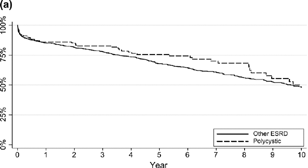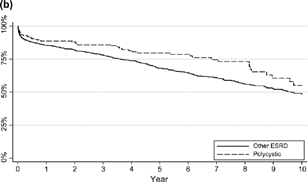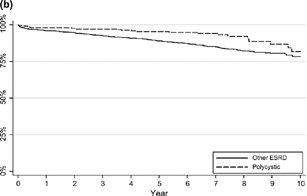Abstract
Graft survival in the autosomal dominant polycystic kidney disease (ADPKD) transplant population at our center was compared to other end stage renal disease (ESRD) transplant recipients (excluding diabetics). There were 1512 adult cadaveric renal transplants carried out at our center between 1989 and 2002. After exclusions, 1372 renal grafts were included in the study. Using Kaplan-Meier methods, patient and graft survival were determined and compared between the two groups. Mean age at transplant was significantly older for the ADPKD group of patients. The age adjusted graft survival at 5 years was 79% for ADPKD patients compared to 68% in the controls. Patient survival for ADPKD patients improved from 89% at 5 years to 95% when age adjusted. Using the Cox proportional hazards models to compare ADPKD with other causes of ESRD (including recipient age and other variables) in a multifactorial model, ADPKD was significant at the 5% level (p = 0.036). This study demonstrates a graft and patient survival advantage in ADPKD patients when age-matched compared to other ESRD patients.
INTRODUCTION
Autosomal dominant polycystic kidney disease (ADPKD) is the most common inherited renal disorder. It is 10 times more common than sickle cell disease, 15 times more common than cystic fibrosis, and 20 times more common than Huntington's disease. It is a systemic hereditary disorder than may occur at any age, and is characterized by cyst formation in ductal organs, particularly the kidney and liver, and by cardiovascular, gastrointestinal, genito-urinary, and musculoskeletal abnormalities.Citation[1]
In a 1990 study at our center, 10.3% of the Irish renal transplant population was found to have had hereditary renal disease (with a male to female ration of 1.63:1) and 64% of these transplant patients were diagnosed with ADPKD.Citation[2] The diagnosis of ADPKD accounts for 4.6% of patients with ESRD in the United States and up to 13% in Europe.Citation[3&4]
It has been shown previously that patients with ADPKD are older than non-ADPKD patients at the time of renal transplantation.Citation[5] There is also evidence to suggest that ADPKD patients with ESRD have an increased risk of cardiovascular diseaseCitation[6] and sepsisCitation[7] after renal transplantation. Despite this, the patient and graft survivals of renal transplant recipients with ADPKD have been comparable to non-ADPKD nondiabetic recipients in many studies worldwide.Citation[4], Citation[7&8]
The purpose of this retrospective study was to examine graft and patient survival rates in the ADPKD population at our center in the period 1989 to 2002 and to compare these outcomes with non-ADPKD kidney transplant recipients transplanted during the same period.Patients with diabetic ESRD were excluded. We also examined the risk associated with graft outcomes for ADPKD compared to other ESRD patients, in conjunction with chosen clinical and demographic variables.
PATIENTS AND METHODS
The data for this study was obtained from the Irish Renal Transplant Registry. The registry includes data from all renal transplants carried out in the Republic of Ireland from the time of inception of the renal transplant program in 1964. The patient data is regularly updated to determine current graft function, graft loss, or patient death.
This is a retrospective study comparing ADPKD renal transplant recipients to non-diabetic, non-ADPKD renal transplant patients in the period between 1989 and 2002 in the Republic of Ireland. In 1989 the quality of the registry data improved when on increased number of variables became available for analysis purposes.
In order to prevent confounders, we excluded all pediatric transplant patients from the study, where pediatric was defined as aged less than 18 years at the time of transplant. Patients with ESRD caused by diabetes mellitus were excluded from the control group as in similar studies,Citation[4], Citation[7&8] as both the patient and graft survival in this group are significantly lower than in other groups.Citation[9]
There were 1512 cadaveric renal transplants carried out in adults during this time period, where “adult” was defined as greater than 17 years of age at the time of transplant. After excluding diabetic patients, 1372 renal grafts remained for analysis in the study. Of these grafts, ADPKD was the cause for ESRD in 12.73% of those transplanted, which accounted for 187 renal transplants for 176 recipients. The control group of nondiabetic, non-ADPKD adult recipients gave a total of 1185 grafts for 1085 patients. Patient follow-up was to date of graft failure or last date of follow-up (the majority of patients were followed-up to early 2002). Patients who died with a functioning graft in situ were included as graft failures. For patient survival, the endpoints used were time from first transplant to end of study or until death. All patients received oral steroids, a calcineurin inhibitor, and either azathioprine or mycophenolate mofetil.
Statistics
Pearson Chi-squared tests and Wilcoxon rank-scored methods were used to compare differences in the demographic table depending on whether analysis was for categorical or continuous variables. Kaplan-Meier survivor functions, both unadjusted and adjusted for age, were used to estimate survival probabilities at different time periods.
Risk analysis for ADPKD and other relevant variables was measured using Cox proportional hazard models. A multifactorial model was developed to analyze the independence of effect of ADPKD in the presence of other confounding variables. Results were deemed significant for probability of equality between groups less than 5% (p < 0.05). The software used for analyzing the data was Stata (V8, Stata Corporation, Texas, USA).
RESULTS
gives the demographic summary of the ADPKD and other ESRD patients. There were significantly more females patients in the ADPKD patient group compared to the control patient group. The other main feature was the mean age at transplant, which was significantly older for the ADPKD patients. Other variables of interest included the mean donor age, which was higher in the ADPKD patients and the number of previous transplants, which was higher in the control group.
Table 1 Recipient characteristics of adult polycystic renal and other ESRD patients
Using Kaplan-Meier product limit methods, graft and patient survival were calculated for the ADPKD patients and compared to the control patients at 1, 5, and 10 years after transplantation.
Graft survival for the ADPKD patients at 1, 5, and 10 years was 85.92%, 75.55%, and 49.98% respectively in comparison to other ESRD survival rates at 1, 5, and 10years of 85.21%, 67.84%, and 48.15% respectively . Median graft survival was 9.71 years (95% C.I. of 8.23–11.74 years) for the ADPKD patient group and 9.63 years (95% C.I. of 8.68–10.23 years) for other ESRD patients.
Due to significant age differences detected between ADPKD and controls, age-adjusted survivor functions were constructed for the two groups. The results of age-adjusted outcomes show significantly improved ADPKD graft survival rates of 88.23% at 1 year, 79.07% at5 years, and 54.30% at 10 years compared to results of 85.46%, 68.14%, and 48.61% for other ESRD patients for the same time periods .
Cox proportional hazards models were run to assess the risk factors associated with graft outcomes for selected variables along with the risk associated with ADPKD. In the model, ADPKD shows significance at the 5% level in the presence of other variables (). The hazard ratio of 0.72 indicates a reduced risk of graft loss for ADPKD patients independently of other confounding variables. Other variables, significant at the 5% level as indicators of graft loss include: recipient age at transplantation, donor age at transplantation, delayed graft function posttransplantation, high levels of PRA, and donor gender.
Table 2 Cox proportional multifactorial model
Patient survival results were also calculated. The unadjusted 1, 5, and 10 year patient survival rates were 95.06%, 89.29%, and 69.94%, respectively for ADPKD patients and 94.94%, 86.67%, and 75.49% for other ESRD patients. Age-adjusted 1, 5, and 10 year patient survival rates were 98.05%, 95.41%, and 81.80% for ADPKD patients and 96.03%, 88.99%, and 78.38% for other ESRD patients. Age-adjusted patient survival demonstrates considerable improvements in survival outcomes. This can be seen graphically by comparing (a) and (b). However, when a multifactorial Cox regression model combining age at transplant with ADPKD was run, statistical significance for ADPKD was not reached (hazard ratio 0.74, 95% C.I. 0.48–1.13, p = 0.164).
DISCUSSION
Hadimeri et al.Citation[4] studied 874 renal transplant recipients in Sweden between 1985 and 1993, 114 of whom had ADPKD. Control patients were matched for age, sex, and donor type. However when the ADPKD patients were compared to controls, graft and patient survival were not significantly different. Stiasny et al.Citation[7] discovered similar outcomes using 80 ADPKD transplant patients and 88 nondiabetic transplant patients. Comparable graft and patient survival were discovered at 5 years posttransplant (73% graft survival in the ADPKD group, 70% in the control group, 84% patient survival in ADPKD patients, and 79% in control patients).
The long-term outcome of renal transplantation in 54 ADPKD patients and 107 non-diabetic, non-ADPKD patients was studied by Fitzpatrick et al.Citation[8] These patients were matched for age, gender, year of transplantation, and source of the allograft. The overall patient and graft survival with a functioning first renal allograft were similar in both groups. Florijn et al.Citation[6] also evaluated patient and graft survival in 101 ADPKD transplant patients and 692 nondiabetic transplant controls. The study was adjusted for significant variables including age and, again, a similar patient and graft survival was shown between the ADPKD patients and the control patients.
The studies described earlier, failed to show a similar graft survival advantage in the ADPKD patient group to that which we have found at our center. In particular, patients with diabetes were excluded from the non-ADPKD patient group in these studies as in our study. The proportion of ADPKD patients in the studies conducted by Hadimeri et al.Citation[4] and by Florijn et al.Citation[6] is similar to our study (12%–13%). All of the studies mentioned earlier had fewer numbers of ADPKD patients. The number of patients available for analysis affects the power of the study to detect meaningful differences in survival outcomes. With 187 renal transplants for the ADPKD group, our study had more power to detect significant effects for graft and patient outcomes.
United States data from the joint Organ Procurement and Transplantation Network (OPTN) and Scientific Registry of Transplant Recipients (SRTR) annual report in 2003Citation[10] showed a similar graft and patient survival advantage in ADPKD transplant patients compared to other transplant patients when adjusted for age and other important variables. The adjusted 5-year-graft and patient survival was 86.7% and 91.6%, respectively, in ADPKD patients and 78.5% and 86.4%, respectively, in non-ADPKD patients according to the OPTN/SRTR data.
The principle reason why results by multifactorial modeling in our study show favorable graft survival outcomes for ADPKD patients, relates to the age at transplant, which was significantly older for this group. Older patients tend to have poorer graft survival rates. However, our ADPKD patients had similar rates of survival, with graft survival estimates at 1, 5, and 10 years comparing favorably with other transplant patients. When the survivor functions were adjusted for age, considerable improvements for ADPKD patients were noted (age-adjusted 5-year graft survival in ADPKD patients was 79.07% vs. 68.14% in control patients). A comparison of (a) and 1 (b), clearly illustrates the improvements in survival estimates when allowance is made for age differences.
Similar improvements are noted for patient survival, although these improvements are not quite so dramatic (a) and (b).
The more favorable outcome in the ADPKD recipients may also be explained by the fact that significantly fewer of these patients had prior transplants when compared to non-ADPKD recipients (p = 0.016) ().Citation[11] Also, there were more female recipients in the ADPKD group vs. the non-ADPKD group (p = 0.002) (). These factors alone or in combination may explain the result of an excellent long-term graft and patient survival in ADPKD renal transplant recipients at our center.
ACKNOWLEDGMENTS
Many thanks to the following:
Renal transplant surgeons at Beaumont Hospital, Beaumont, Dublin 9, Republic of Ireland;
Nephrologists and transplant physicians in the Republic of Ireland;
Irish transplantation coordinators;
Outcome research group; and
Funding from the Beaumont Transplant Foundation.
REFERENCES
- Gabow, P. Autosomal dominant polycystic kidney disease—more than a renal disease. Am. J. Kidney Dis. 1990, 16, 404–413.
- Green, A.; Allos, M.; Donohoe, J.; Carmody, M.; Walshe, J. Prevalence of hereditary renal disease. Ir. Med. J. 1990, 83 (1), 11–13. [PUBMED], [INFOTRIEVE]
- Singh, S.; Hariharan, S. Renal replacement therapy in autosomal dominant polycystic kidney disease. Nephron 1991, 57 (1), 40–44. [PUBMED], [INFOTRIEVE]
- Hadimeri, H.; Norden, G.; Friman, S.; Nyberg, G. Autosomal dominant polycystic kidney disease in a kidney transplant population. Nephrol. Dial. Transplant. 1997, 12 (7), 1431–1436. [PUBMED], [INFOTRIEVE], [CROSSREF], [CSA]
- Sanfilippo, F.; Vaughn, W.; Peters, T.; Bollinger, R.; Spees, E. Transplantation for polycystic kidney disease. Transplantation 1983, 36 (1), 54–59. [PUBMED], [INFOTRIEVE]
- Florijn, K.; Chang, P.; Van der Woude, F.; Van Bockel, J.; Van Saase, J. Long term cardiovascular morbidity and mortality in autosomal dominant polycystic kidney disease patients after renal transplantation. Transplantation 1994, 57 (1), 73–81. [PUBMED], [INFOTRIEVE], [CSA]
- Stiasny, B.; Ziebell, D.; Graf, S.; Hauser, I.; Schulze, B. Clinical aspects of renal transplantation in polycystic kidney disease. Clin. Nephrol. 2002, 58 (1), 16–24. [PUBMED], [INFOTRIEVE], [CSA]
- Fitzpatrick, P.; Torres, V.; Charboneau, J.; Offord, K.; Holley, K.; Zinke, H. Long-term outcome of renal transplantation in autosomal dominant kidney disease. Am. J. Kidney Dis. 1990, 15 (6), 535–543. [PUBMED], [INFOTRIEVE]
- Rischen-Vos, J.; van der Woude, F J.; Tegzess, A M.; Zwinderman, A H.; Gooszen, H C.; van der Akker, P J.; van Es, L A. Increased morbidity and mortality in patients with diabetes mellitus after kidney transplantation as compared with non diabetic patients. Nephrol. Dial. Transplant. 1992, 7, 433–437. [PUBMED], [INFOTRIEVE]
- 2003 OPTN/SRTR Annual Report: Transplant Data 1993–2002 HHS/HRSA/SPB/DOT; UNOS; URREA; (chapter 5); www.ustransplant.org. (accessed Aug 2003).
- Gjertson, D. A multifactorial analysis of kidney regraft outcomes. Clin. Transpl. 2002, 335–349. [INFOTRIEVE], [CSA]



